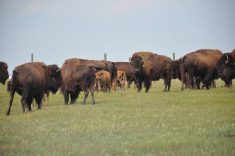A recently released vaccine to prevent bovine respiratory disease has been proven to reduce deaths by as much as half.
Released by Boehringer Ingelheim (Canada) Ltd., the subcutaneous vaccine appears to work well against the disease, which is also known as shipping fever. Respiratory tract infections can be caused by a number of agents and infection is often triggered by stress factors such as heat, dehydration, hunger, noxious fumes, anxiety and injury.
“There is no vaccine that gets all the contributors to respiratory problems,” said Rob Tremblay, a veterinarian with Boehringer Ingelheim.
Read Also

Trump’s tariffs take their toll on U.S. producers
U.S. farmers say Trump’s tariffs have been devastating for growers in that country.
“You try and target the major ones. This vaccine gets two of the genotypes of BVD virus which are important, as well as the IBR virus.”
BRD is a form of pneumonia in feedlot cattle caused by several different viruses and bacteria such as pasteurella. It is found in the upper respiratory tract and can be spread by sneezing and direct nose-to-nose contact
BVD is bovine virus diarrhea, a viral condition that includes fever, ulcers, depression, weight loss, excessive salivation and pneumonia. The vaccine has been on the market for about a year and has been widely used in dairy and beef calves at risk of pneumonia.
The treatment is marketed as Express 3, which protects against BVD, and Pulmo-guard, which is recommended for vaccinating healthy, susceptible cattle
Two large-scale studies in Alberta and Saskatchewan showed overall death losses were between 55 and 71 percent lower using this product compared to some older products on the market.
While this is not a prescription drug, producers are encouraged to work with veterinarians for proper dosage and use.
Respiratory diseases are costly and appear to be more common.
“We don’t really know for sure why problems are on the rise,” Tremblay said. “The last few years the anecdotal evidence is that we are seeing higher levels of treatment and more animals that become chronic and in certain cases higher death losses.”
Cattle may contract a variety of respiratory infections that are more like influenza in humans and can be fatal.
Upper tract infections occur in the nose, throat and windpipe. There is nasal discharge, coughing, fever and poor appetite. Diphtheria, which can be fatal, infects the larynx and is characterized by loud breathing and possibly a restricted airflow. Lower respiratory infections such as pneumonia affect the lungs.















